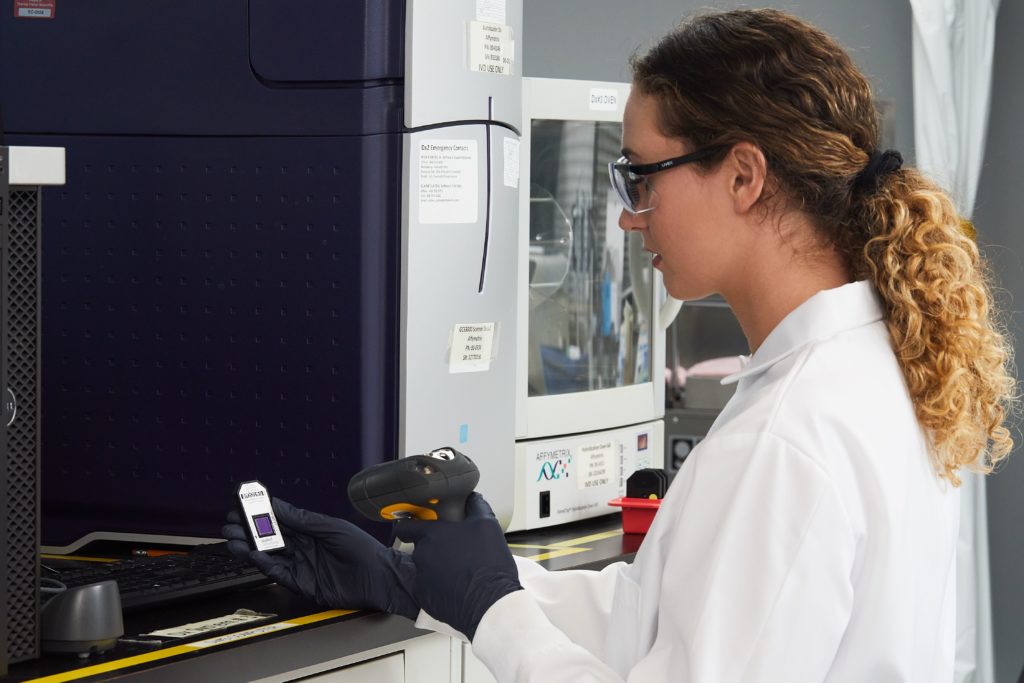Scientists Share Insights About Their Journey
Chromosomal microarrays (CMA) are an important technology for getting genomic information out of tissue and blood samples quickly and effectively. They come in many varieties, each optimized for distinct use cases. GeneDx recently switched to the Applied Biosystems™ CytoScan™ HD Array Kit, a high-resolution whole-genome chromosomal microarray (CMA) containing both copy number variation (CNV) and single-nucleotide polymorphism (SNP) probes, for their prenatal and postnatal testing needs. Dr. Jeanne Meck and Stephanie Warren, from GeneDx, share insights about their journey to implement the CMA platform utilizing this hybrid microarray.
Are All Microarrays Equivalent?
Choosing the Right Microarray
On this, Dr. Meck is adamant: “All microarrays are not equivalent.” Different microarrays have different probe density, probe number, and ability to detect difficult-to-sample traits such as copy number variation. CMAs also differ in their ability to derive useful data from difficult sample types such as buccal swabs and uncultured prenatal specimens. Choosing the right microarray is therefore of the utmost importance. GeneDx settled on the CytoScan HD Array Kit, a hybrid SNP array, because it provides the level of resolution they need to derive results that match the standard of quality expected. The structure of the hybrid CMA is such that the different kinds of probes effectively support each other, with SNP probes able to confirm CNV findings and help detect complex situations like mosaicism and runs of homozygosity (ROH).
Why a Hybrid SNP Array Platform?
Overall Cost of Analysis
Fewer repeat tests and less confirmation means less time and money to run.
“Many of the reasons come back to the DNA,” Dr. Meck explains. The hybrid SNP array tolerates lower DNA quality, enabling GeneDx to use buccal swabs for most of their postnatal cases, which provides a sizable time and cost savings over alternatives. This has been particularly handy during the sudden, massive, ever-increasing demand for SARS-CoV-2 tests, which are principally implemented via at-home buccal swabs. The new hybrid SNP microarray also requires less DNA, which eases performing multiple tests on the same sample, as is common in prenatal testing. “We have been able to reduce the amount of sample necessary by 40%, going from 100 nanograms to a current 60 nanograms,” Dr. Meck reports. Similarly, this enhanced sensitivity reduces the need for culturing samples from amniotic fluid and chorionic villus tests, taking nine days off these tests’ turnaround time. CMAs were already appealing in prenatal testing due to the limited window for acting on any information received, so advanced technology that reduces that time further is welcomed.
Because the hybrid SNP array platform requires less confirmation and fewer repeat tests, it ultimately costs less time and money to run than some alternatives Dr. Meck has tested, including some that nominally take less time to run but might have to be repeated. As she puts it, “if we need less repeat testing, have reduced culture needs, and need less time assessing the quality of data or analyzing calls, then the overall cost of analysis is lower. Our confidence factor is higher when we do not have to repeat tests for calls that may or may not be real.” Their previous platform, by comparison, was difficult to troubleshoot and often required their team to repeat arrays multiple times to verify borderline results.
Additionally, because GeneDx’s hybrid SNP array is an off-the-shelf product rather than a custom item, when their stock is low, they can simply order more rather than wait for a custom item to be manufactured to order.
Related: Hybrid-SNP Microarrays for Uniparental Disomy (UPD)
Should You Switch to Hybrid SNP Arrays?
Consider the Whole Picture of Solutions and What They Do for You
Stephanie Warren advises other labs that are interested in whole-genome CMA to consider the whole picture of what various solutions offer them, including monetary cost, time, many measures of efficacy, and more. Getting hung up on specific advantages or disadvantages may mean losing out on important benefits one is not considering with similar zeal. As she puts it, “the benefits that we have talked about, such as DNA tolerance, decreased repeat rate, reduced need for alternative confirmation methods, and the ease and intuitiveness of the analysis software, outweigh the disadvantages” of taking longer per-run than some alternatives.
Switching CMA platforms can be time-consuming but, in Warren’s assessment, it is well worth the effort and cost, especially with the aid of vendor partnerships. “Don’t think you have to do it alone,” she exhorts. “Work with the vendor specialist when challenges arise.”
Watch the whole testimonial series and download the GeneDx Scientist Spotlight:
» GeneDx Boosts Accuracy and Efficiencies with Hybrid-SNP Arrays
Related: CytoScan Resources
» Applications and Technical Notes
» Blog Posts
» Literature
» Infographics
» Posters
» Scientist Spotlight
» Videos
» Webinars
Learn More
» Applied Biosystems™ CytoScan™ HD Array Kit and Reagent Kit Bundle
» Reproductive Health Research Solutions – Building brighter futures together.
» Microarray Analysis – Advance your research with innovative products, tools, and resources.
Leave a Reply